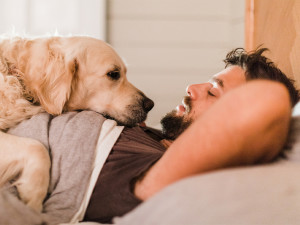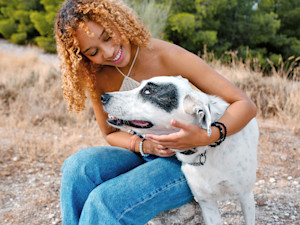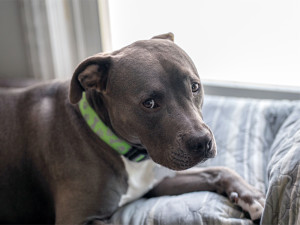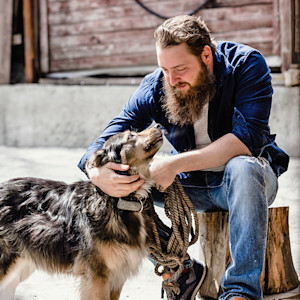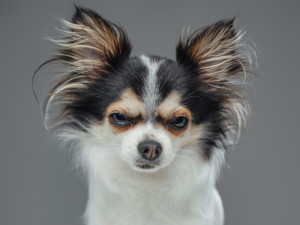Why Does My Dog Look Sad? Determine if Your Dog Needs Help
What’s wrong, buddy?

Share Article
In This Article:
Common Reasons Your Dog May Look Sadopens in a new tab How to Help Your Dog When They’re Sadopens in a new tab When Should You Seek Professional Help?opens in a new tab
We dog parents can be forgiven for anthropomorphizing our beloved petsopens in a new tab—that is, ascribing emotions to them that might not be entirely accurate. Those woeful looks tug at our heartstrings and lead to concern. Dogs have strong eyebrow muscles that make them expressive but if your dog is truly sad, look beyond those puppy dog eyes for lethargy, a change in appetite and other behavioral shifts.
“Since dogs can’t voice discomfort, it often shows in their behavior,” says Steve Scott, a certified dog trainer, behaviorist and owner of Scott’s K9opens in a new tab. Scott pursued a career in law enforcement after his service in the Army and earned honors as the head trainer of his police department’s K9 Unit. He now provides family protection dogs for clients nationwide.

littleKin™ is Kinship’s home just for puppy and kitten parents. Bop over to check out expert advice, new pet tools, and special deals—all curated for your newest family member.
opens in a new tabSome dogs simply look more sad than others, says Colby Julien, a dog behaviorist and dog trainer at Geo-Sniffingopens in a new tab, an outdoor scent pod discovery game for dogs. Sad-looking eyes can be genetic in some dogs and can even be advantageous. “This is because sad-looking dogs get the most treats and attention,” Julien says. “Wolves evolved to be more appealing to humans, which is why puppies have big eyes like babies. Their large, round eyes and ability to raise their inner eyebrows mimic human babies’ expressions of sadness, triggering our instinct to care for them.”
Common reasons your dog may look sad
Health issues
Health issues like physical discomfort, pain and chronic illness opens in a new tabcan be underlying issues of a sad expression. Scott says an ongoing health issue such as arthritis will affect mood. He says if you notice your dog is withdrawn, sluggish or avoiding activities they used to enjoy, this might be a sign they’re dealing with physical discomfort or injury.
Other signs are accidents in the house, destructive behavior, excessive clinginess or nighttime restlessness. Dental issues are another underlying cause of depression. Dogs are stoic creatures. Older dogs who are more prone to health issues should be examined if the concerning behavior persists. If you suspect a health problem, consult your veterinarian.
Emotional states
Dogs are creatures of habit. Scott says for some dogs, changes in routine can lead to anxiety and stress. “This can include small changes like noise, or large changes such as loss of another pet or family member. Behaviors like pacing or whining, as well as a lack of appetite can be a sign your dog is feeling unsettled,” he says.�
It’s a testament to the growing awareness of human mental health that we now consider dogs may get depressedopens in a new tab, too. First, rule out underlying health issues with your veterinarian. Then, if you think there’s another reason your dog is acting withdrawn, experiment with caring gestures to boost your dog’s mood. Engage in an extra grooming session, go for a long walk and let them sniff all they want, or get them a new toy. Remember, dogs feel grief, too.
Sometimes it’s your sadness that triggers your dog’s sad expression. Dogs are sensitive, highly intuitive creatures who pick up on your sadnessopens in a new tab. They may sit beside you, try to lick you, nudge you or give you uncanny looks of understanding. Thank them when they do. And never direct your strong emotions at them. That makes your dog look sad because they’re trying to appease you and avoid conflict.
“Many people mistakenly believe that this ‘sad’ look means the dog feels guilty for doing something wrong but in reality, it is a learned response trying to prevent conflict, not an expression of guilt,” Julien says. “This is usually triggered by a human facial expression, yelling or anger. The best way to avoid this behavior is to check your own behavior that’s causing this appeasement behavior.”
Changes in environment
Change is a big destabilizer for all of us. Moving to a new home, introducing a new family member or a new pet affects your dog’s emotional state, Scott says. “Proper training and structure can help alleviate behavior issues associated with environmental changes,” he says.
Other changes might include the death of a family member or another pet, a child going to college and divorce. Just like us, dogs experience emotion surrounding change. If the change in environment is something you can plan for, try to be extra disciplined about feeding, exercise and training or bonding time before and after the change so your dog can rely on that routine amid the upheaval.
Changes in the natural environment, especially thunderstorms, are another cause of stress and sadness in dogs. My dog Lilac seems to become more sad and anxious during high wind events while her littermate, Willy, hides under the bathroom sink during thunderstorms. In both cases, I try to soothe them and offer them treats and distraction.
Lack of stimulation
Willy reminds me with a sad expression that he’s disappointed if I postpone his morning walk. He’ll follow me around with a dejected look until I tell him it’s time to go out, then he’s exuberant. Scott says dogs need physical activity and mental engagement. “If your dog isn’t getting enough exercise, they may feel restless or bored, which can come across as sadness,” he says.
Dogs also thrive on companionship. If they’re left for long periods of time without company or an activity like a puzzle feeder, they’ll become despondent. “Being left alone for long hours without interaction can lead to emotional withdrawal,” Scott says.
Willy’s fortunate to have Lilac for company and me working at home but when no one’s home for most of the day, I’ll hire a dog sitter or ask a friend to let them out.
How to help your dog when they’re sad
Ensure physical health: The first stop in troubleshooting your dog’s sad expression is checking their physical health. Scott says rule out health problems and consult your vet if you think something is physically wrong. Health issues are often the cause of persistent sad behavior.
Provide emotional support and social activity: Your dog appreciates your attention and will likely perk up if you prioritize quality time together, Scott says. Dogs enjoy socializing with other dogs, too. Set up a doggy play date or visit the dog park. Something else to consider is your dog’s background. If you know they come from an abusive background, they may be more likely to suffer bouts of stress and anxiety.
Provide physical and mental activity: Propose a walk or engage in a training session to provide mental stimulation. “Boost your dog’s confidence with activities like dog parkour, scent workopens in a new tab (non-food-based), or agility trainingopens in a new tab,” Julien says.
When should you seek professional help?
If none of the usual enticements work, negative behaviors persist, and you notice other changes in your pup’s normal demeanor, Scott advises reaching out to a professional.
Bottom line
As a dog parent, you can expect to see puppy dog eyes. It might mean your dog is angling for a treat. Maybe they heard the crinkle of a bag that sounded like it should contain treats but didn’t. Or maybe it’s something more serious like a health issue, which is usually accompanied by changes in appetite and activity.
A big change in a dog’s home environment like the death of another pet or a family member brings down the mood of the everyone in the household. A growing body of research shows dogs are very responsive to the sadness and tears of people around them (as if we dog parents didn’t already know that).
FAQs
Why does my dog look sad?
Dogs can look sad for a number of reasons including health issues, a change in their environment, a lack of exercise and socialization or even because they’re picking up on your sadness.
What can I do if my dog looks sad?
Try distracting them with a walk, a treat, or something they enjoy like a trip to the dog park.
When should I be concerned if my dog looks sad?
If your pup normally bounces to the door at the suggestion of a walk but now remains on the floor with their nose between their paws or turns away from a treat with a doleful expression, it’s wise to consult your veterinarian.
Should I worry if my dog looks sad?
Generally, no. Dogs look sad because, like us, they experience a range of emotions. Your dog may be ready for attention or a walk. If that doesn’t change their mood though, look for other behavioral changes that indicate a health issue, stress, or anxiety.
What makes my dog sad?
Changes in a dog’s environment (think moving or the arrival of a squalling new family member) will confuse them and make them appear sad. The same change may also mean they’re getting less attention. Try sticking to a predictable routine and getting them out more or enlist someone to help you. Maybe your dog is picking up on your sadness. In that case, building in time for extra walks and bonding will help you both.
Can dogs get depressed?
Yes, dogs can experience depression. A change in routine, the loss of another pet and the departure or death of a close family member can all make a dog withdrawn. Like us, they need to grieve and adjust. Try perking them up with novel treats, activities and exercise.
References
“Anxious Behavior: How to Help Your Dog Cope with Unsettling Situations.” Cornell University College of Veterinary Medicine, 3 Aug. 2022, www.vet.cornell.edu/departments-centers-and-institutes/riney-canine-health-center/canine-health-information/anxious-behavior-how-help-your-dog-cope-unsettling-situationsopens in a new tab.
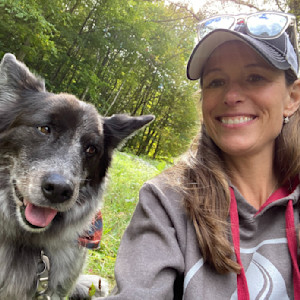
Catherine Fahy Green
Catherine Fahy Green is a journalist turned PR specialist whose work appears in numerous places as press releases and stories about fun products people should try. She lives with her family in Western Massachusetts where she listens closely to the stories her dogs, chickens, and horses tell her.
Related articles
![Man and golden retreiver laying on stomach looking at each other in bed]() opens in a new tab
opens in a new tabDog Whimpering: Why a Dog’s Whimper Affects Us
To pet parents, a whimpering dog sounds as sad as a crying baby. Here’s why.
![Woman hugging her dog outside.]() opens in a new tab
opens in a new tabYour Dog Can Understand Your Facial Expressions, Study Says
And they love it when you smile.
- opens in a new tab
No, Your Dog Does Not Feel Guilt—Here’s What Those “Regretful” Looks Really Mean
Your pup doesn’t actually feel bad about eating your pizza.
![Man looking into his dog's eyes.]() opens in a new tab
opens in a new tabWe’re Not as Good at Reading Our Dogs’ Emotions as We Thought, Study Finds
People struggle to recognize fear and frustration the most.
![Angry pomeranian chihuahua pup on a dark gray background]() opens in a new tab
opens in a new tabIs Your Dog Giving You the Stink Eye?
Despite plenty of reasons to get mad, an animal behaviorist says dogs rarely express real anger.
- opens in a new tab
Can Dogs Feel Guilt?
They do look very sorry...


